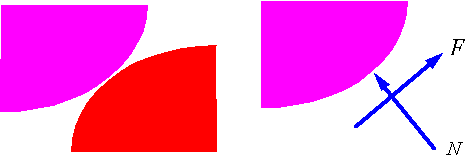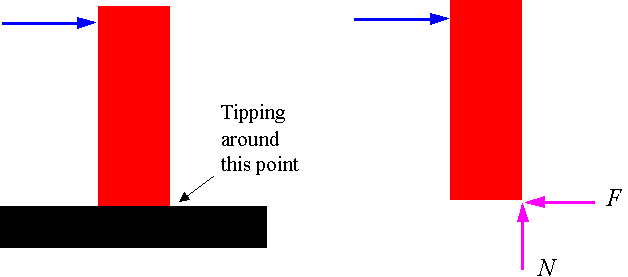Friction force: When two surfaces come into contact, forces are applied by each surface on the other. The part which is tangent to the contacting surfaces is called the frictional force. If the two surfaces in contact do not move relative to each other, one has static friction. If the two contacting surfaces are moving relative to each other, then one has kinetic (dynamic or slipping) friction.
Static Friction: The frictional force F that can result between two surfaces without having the surfaces slide relative to each other is bounded by the equation
![]()

where N is the normal force to the surface, and ![]() is the static coefficient of friction.
is the static coefficient of friction.
Kinetic friction: The frictional force F that results when two surfaces are sliding on each other is proportional to the normal force applied on the surfaces and is directed opposite to the relative motion of the surfaces. The factor of proportionality is the coefficient of kinetic friction, ![]() , and the equation for F is
, and the equation for F is
![]()
In general the coefficient of kinetic friction is smaller than the coefficient of static friction, which explains the initial difficulty of getting an object to slide.
Pending motion: Pending motion refers to the state just before surfaces start to slip. In this case the static frictional force has reached its upper limit and is given by the equation ![]() . The direction of the frictional force is opposite to the pending relative motion of the surfaces.
. The direction of the frictional force is opposite to the pending relative motion of the surfaces.
Tipping: When a object starts to tip, it starts to pivot around a point. As a result the contact forces (frictional and normal) must be applied at the pivot point. If the object tips before it slips, then one can find the frictional force from the equations of equilibrium.

Calculating the location of the normal force: If the contact is a surface as opposed to a point, then there is a distribution of normal and frictional forces on that surface. The location of the resultant normal force can be determined from the equilibrium equations.

Source: http://occonline.occ.cccd.edu/online/mkhakbazan/Dry%20Friction.doc
Web site to visit: http://occonline.occ.cccd.edu
Author of the text: indicated on the source document of the above text
If you are the author of the text above and you not agree to share your knowledge for teaching, research, scholarship (for fair use as indicated in the United States copyrigh low) please send us an e-mail and we will remove your text quickly. Fair use is a limitation and exception to the exclusive right granted by copyright law to the author of a creative work. In United States copyright law, fair use is a doctrine that permits limited use of copyrighted material without acquiring permission from the rights holders. Examples of fair use include commentary, search engines, criticism, news reporting, research, teaching, library archiving and scholarship. It provides for the legal, unlicensed citation or incorporation of copyrighted material in another author's work under a four-factor balancing test. (source: http://en.wikipedia.org/wiki/Fair_use)
The information of medicine and health contained in the site are of a general nature and purpose which is purely informative and for this reason may not replace in any case, the council of a doctor or a qualified entity legally to the profession.
The texts are the property of their respective authors and we thank them for giving us the opportunity to share for free to students, teachers and users of the Web their texts will used only for illustrative educational and scientific purposes only.
All the information in our site are given for nonprofit educational purposes